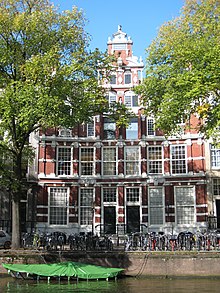Herengracht
The Herengracht (German "Herrengraben") is the innermost of the three to the canal belt belonging, concentrically around the old city of Amsterdam around landscaped canals . It is located to the west and south of the medieval city center, its extension beyond the Amstel river , the Nieuwe Herengracht (German "New Herrengraben"), east of the old town. The former medieval Singel moat runs parallel to the Herengracht , outside the Keizersgracht .
The Herengracht was built in two construction phases around 1613 and around 1664. The most famous architectural monuments include the baroque city palaces of some of Amsterdam's richest families in the Gouden Bocht (Golden Arch).
history
The construction work on the Herengracht began in 1612 on the initiative of Mayor Frans Hendricksz. Oetgens , city architect Hendrick Jacobsz Staets and city surveyor Lucas Jansz Sinck.
At the beginning only a canal was created to open up the workshops of the Reepschläger , i.e. the manufacturers of ship ropes, who had settled outside the old city moat (today's Singel). After it was widened and converted into a city canal in 1612, the canal was named Herengracht in honor of the city lords of Amsterdam .
The first construction phase, begun in 1612, was in the west of the old town and stretched from Brouwersgracht to Leidsegracht. The second section up to the Amstel was built from 1658 onwards. In this part lies the Gouden Bocht , the most splendid part of the street, in which many of Amsterdam's most powerful and wealthy councilors and merchants built new city palaces. The city's merchants had made great fortune through trade with South America and the Dutch East Indies . The Amsterdam architects Philips Vingboons (1607–1678) and Adriaan Dortsman (1635–1682) designed many of these representative town houses.
The last construction phase, the Nieuwe Herengracht, was built near what was then the Jewish quarter of Amsterdam, between the Amstel and IJ rivers . Due to an economic crisis, it took a long time for the extension to be fully built on.
Cross-section and course
The street consists of a wide navigable canal in the middle, which is limited on both sides by a drivable road to the development of the houses and spanned by a total of eleven bridges at the level of cross streets. As usual in Amsterdam's old town, the road embankments are now designated as one-way streets, so that the canal forms a broad median.
According to the typical old Dutch construction, the plots are usually deep, but only have a narrow street front.
The Herengracht has a length of 2.4 kilometers and begins in the northwest of the old town on the Brouwersgracht . It initially runs in a south-westerly direction. South of the junction of the Leliegracht , at the theater museum , it makes a bend in a southerly direction. Further bends on the Leidsegracht , the Nieuwe Spiegelstraat (this bend is the Gouden Bocht ) and the Reguliersgracht direct the course in an easterly direction until the Herengracht meets the natural river Amstel in the south of the old town . This course is almost identical to the other two canals of the canal belt, the Keizersgracht and the Prinsengracht .
A little north of the confluence of the Herengracht, the Blauwbrug, opened in 1883, leads over the Amstel.
Across the Amstel is the short Nieuwe Herengracht , which leads to Entrepotdok and is crossed by four other bridges, including the Weesperstraat . Its eastern continuation beyond this harbor basin is called Schippersgracht .
Trams cross the Herengracht at the Raadhuisstraat, Leidsestraat , Vijzelstraat and Utrechtsestraat . The Nieuwe Herengracht is also crossed by the tram along the Muiderstraat and under the Weesperstraat by the subway ; Waterlooplein station is north of the canal .
All sections of the canal belong to the Amsterdam-Centrum district .
Well-known structures
There are many magnificent monumental townhouses on the Herengracht, including:
- Herengracht 59: De Hond (1659)
- Herengracht 120: De Coningh van Denemarken (1615)
- Herengracht 170–172: Huis Bartolotti / Het Bonte Huis (around 1617), seat of the theater museum
- Herengracht 203: Koopmanshuis (around 1618)
- Herengracht 274: De Witte Leli (1739)
- Herengracht 284: Huis Van Brienen ( Van Brienen van Ramerus family ) (1728)
- Herengracht 361: Sonnenberg (around 1655)
- Herengracht 366-368: Cromhouthuizen (Family Cromhout ) (1660 and 1662), seat of the Bible Museum
- Herengracht 380: Nederlands Instituut voor Oorlogsdocumentatie (Dutch Institute for War Documentation)
- Herengracht 394: Four Heemskinderen (around 1671)
- Herengracht 446: Huis van der Graeff , city palace by Andries de Graeff at Gouden Bocht
- Herengracht 450: Huis van Deutz ( Deutz van Assendelft family ) (1663)
- Herengracht 462: Sweedenrijk (1672)
- Herengracht 475: Huis de Neufville (Huis aan de Bocht) (1731/33)
- Herengracht 476: Huis de Vicq ( De Vicq family ) (1670)
- Herengracht 502: Huis met de Kolommen (1672), the official residence of the mayor
- Herengracht 518: Museum Haus Geelvinck-Hinlopen
- Herengracht 573: which now houses the Hendrikje Cup Museum ; former town house of Cornelis de Graeff
- Museum Het Grachtenhuis from the 17th century, is a listed building ( Rijksmonument )
The preserved historical gardens include:
- The historic garden behind no.168
- G. Belin la Garde's garden and summer house behind No. 412
See also
- Canals in Amsterdam
- Nine streets , side streets of the Amsterdam canal belt
Web links
- Theater Museum, Herengracht 168 (English)
- Huis Bartolotti, Herengracht 170. Website of the City of Amsterdam (Dutch)
- Huize van Brienen, Herengracht 284. Website of the City of Amsterdam (Dutch)
- Cromhouthuis, Herengracht 368 (English)
- Herengracht. Amsterdamse grachtenhuizen, Panoramas of the houses on the Herengracht (Dutch)
Coordinates: 52 ° 22 ′ 3 ″ N , 4 ° 53 ′ 12 ″ E




